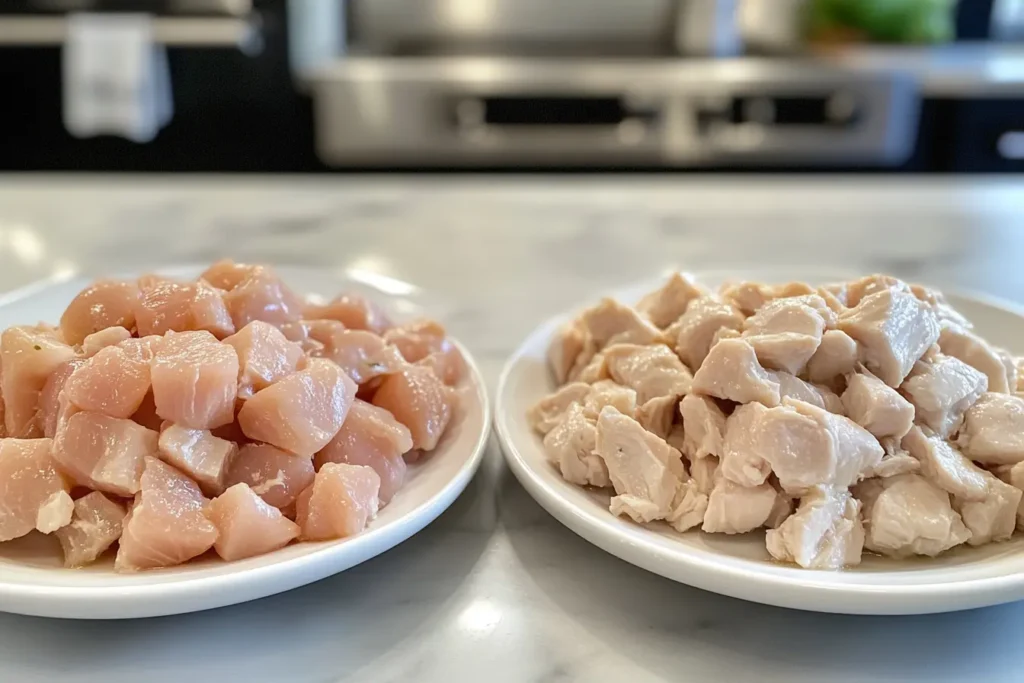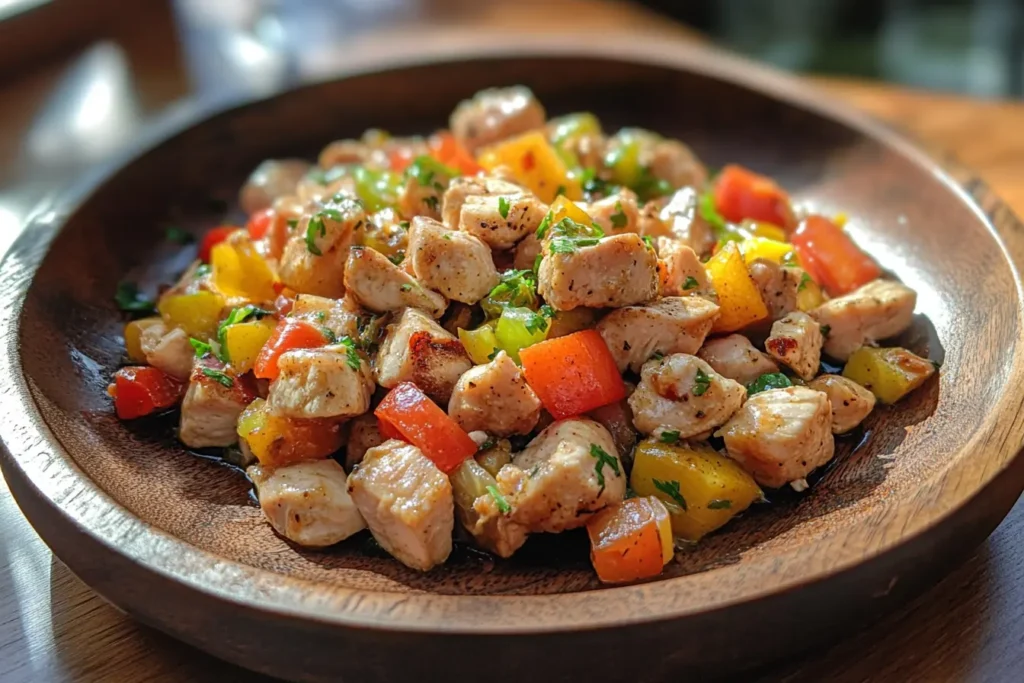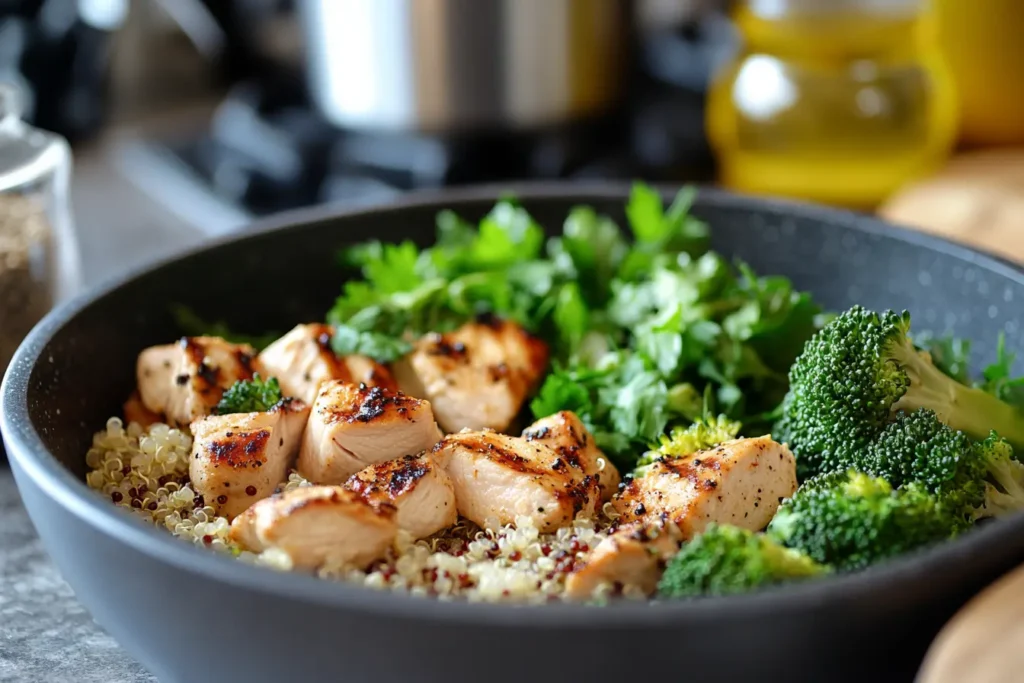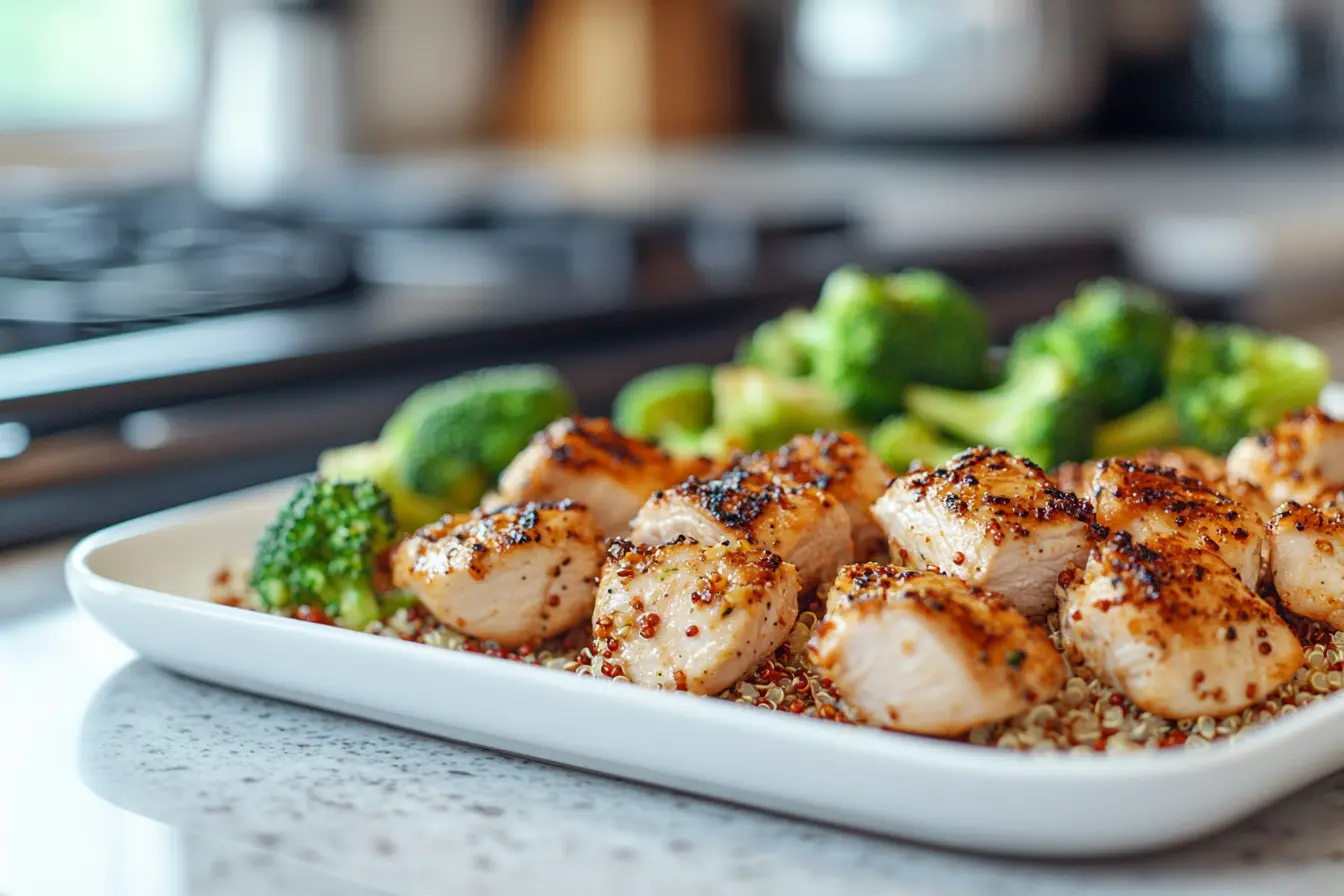Introduction
Diced chicken is a staple in many kitchens, prized for its versatility and quick preparation. But how healthy is it really? This article delves into the nutritional aspects of diced chicken, its potential benefits, and risks, while also exploring how different cooking methods influence its healthiness. By the end, you’ll have a clear understanding of whether diced chicken deserves a spot in your balanced diet.
Nutritional Profile of Diced Chicken
Macronutrient Composition
When we talk about diced chicken, its macronutrient profile is a standout feature. Packed with high-quality lean protein, diced chicken provides essential amino acids that help in muscle repair and overall health. A 100-gram serving of chicken breast contains approximately 31 grams of protein, making it an excellent choice for those seeking a protein-rich diet. Additionally, it is low in fat, with only about 3.6 grams of total fat per serving.
Moreover, diced chicken contains negligible carbohydrates, making it an ideal component for low-carb diets. The minimal calorie count—about 165 calories per 100 grams—further supports its place in calorie-conscious meal plans.
Vitamins and Minerals
Beyond macronutrients, diced chicken boasts a plethora of essential vitamins and minerals. It is a rich source of B vitamins, particularly B3 (niacin) and B6, which are vital for energy metabolism and brain health. Additionally, it provides essential minerals like phosphorus, selenium, and zinc, which support bone health, immunity, and cellular function.
Interestingly, selenium in chicken plays a critical role as an antioxidant, helping combat oxidative stress. On the other hand, the phosphorus content contributes to maintaining strong bones and teeth.
In the next installment, we’ll discuss the numerous health benefits diced chicken offers and how it can aid in weight management and muscle health.
Health Benefits of Diced Chicken
Protein Content and Muscle Health
One of the most well-known health benefits of diced chicken is its impressive protein content. Protein is the building block of muscles, and consuming adequate amounts aids in muscle repair, growth, and maintenance. Whether you’re an athlete or simply leading an active lifestyle, incorporating diced chicken into your meals can help you meet your protein needs effortlessly.
Chicken also contains essential amino acids, which are crucial for tissue repair and maintaining lean body mass. Unlike many other protein sources, chicken is relatively low in saturated fat, making it a heart-healthy choice.
Weight Management Advantages
Diced chicken is not just about building muscle; it’s also a fantastic option for weight management. Its low calorie and high protein composition promote satiety, keeping you fuller for longer periods and reducing the likelihood of overeating. When combined with fiber-rich vegetables and whole grains, diced chicken can play a vital role in a balanced diet that supports weight loss or maintenance.
Healthy Diced Chicken Recipe
Here’s a delicious, easy-to-make recipe that showcases the versatility of diced chicken. It’s a perfect dish for those looking to enjoy a nutritious, flavorful meal.

Ingredients:
- 500g fresh diced chicken breast
- 1 tablespoon olive oil
- 1 cup chopped bell peppers (red, yellow, and green)
- 1 medium onion, diced
- 2 cloves garlic, minced
- 1 teaspoon paprika
- 1 teaspoon cumin
- ½ teaspoon turmeric
- Salt and pepper to taste
- 2 cups cooked quinoa or brown rice (optional, for serving)
- Fresh parsley or cilantro for garnish (optional)
Step-by-Step Cooking Instructions:
- Prepare the Ingredients:
Wash and pat dry the diced chicken. Chop the vegetables and set them aside. - Marinate the Chicken:
In a bowl, toss the chicken with paprika, cumin, turmeric, salt, and pepper. Let it marinate for about 15 minutes to enhance flavor. - Heat the Pan:
In a large skillet or non-stick pan, heat the olive oil over medium heat. - Cook the Chicken:
Add the diced chicken to the skillet and cook for 5–7 minutes, stirring occasionally, until the pieces are golden brown and cooked through. Remove the chicken from the pan and set it aside. - Sauté the Vegetables:
In the same skillet, add the onions and garlic. Sauté for 2 minutes until fragrant. Add the bell peppers and cook for an additional 4–5 minutes until tender but slightly crisp. - Combine and Serve:
Return the cooked chicken to the skillet and toss everything together. Let it cook for another 2 minutes to meld the flavors. Serve hot over cooked quinoa or brown rice, garnished with fresh parsley or cilantro.
Nutritional Content (Per 100g)
Below is the nutritional content for diced chicken when prepared according to the above recipe:
| Nutrient | Amount |
|---|---|
| Calories | 165 kcal |
| Protein | 31g |
| Fat | 3.6g |
| Carbohydrates | 0g |
| Sodium | 75mg |
| Selenium | 24.3µg |
In the ensuing segment, we’ll explore potential health concerns associated with diced chicken, focusing on cholesterol, sodium, and processed varieties.
Potential Health Concerns of Diced Chicken
Cholesterol and Saturated Fat Levels
While diced chicken is celebrated for its lean protein content, it’s essential to consider its cholesterol levels. A 100-gram serving of chicken breast contains approximately 85 mg of cholesterol, which is about 28% of the recommended daily intake. For individuals with high cholesterol or heart conditions, consuming chicken in moderation and opting for lean cuts like the breast is advisable.
Saturated fat content in fresh diced chicken is relatively low—approximately 1 gram per 100 grams. However, excessive intake of saturated fats from other dietary sources can compound the risks, so balanced meal planning is crucial.
Sodium Content in Processed Diced Chicken
If you’re reaching for processed or pre-seasoned diced chicken, you might want to check the nutrition label carefully. These products often contain high levels of sodium due to preservatives and flavor enhancers. Excessive sodium intake is linked to high blood pressure and cardiovascular issues.
For example, processed diced chicken can contain up to 500-600 mg of sodium per 100 grams, compared to fresh chicken, which has just 75 mg of sodium. Whenever possible, choose fresh chicken and season it yourself with herbs and spices to keep sodium levels in check.

Tips to Minimize Health Risks
- Choose Fresh Over Processed:
Opt for fresh, skinless chicken breast over processed varieties to avoid unnecessary additives and sodium. - Trim Visible Fat:
If using dark meat or skin-on chicken, trim visible fat to reduce saturated fat content. - Use Heart-Healthy Cooking Methods:
Grilling, baking, or steaming are excellent ways to prepare diced chicken without adding unhealthy fats. - Balance Your Meal:
Pair chicken with whole grains and fiber-rich vegetables to counterbalance sodium and cholesterol intake.
In the next division, we’ll dive into a comparative analysis of diced chicken versus other protein sources, including red meat and plant-based options, shedding light on its unique benefits.
Comparative Analysis: Diced Chicken vs. Other Proteins
Diced Chicken vs. Red Meat
When comparing diced chicken to red meat, several key differences emerge, particularly in terms of health impact. Chicken, especially breast meat, is significantly lower in saturated fat and cholesterol compared to red meat, such as beef or lamb. For instance, a 100-gram serving of lean chicken breast contains 1 gram of saturated fat, whereas the same portion of lean ground beef contains approximately 5 grams.
Chicken also contains fewer calories, making it a better choice for those focused on weight management. Additionally, red meat has been linked to an increased risk of certain health conditions, such as heart disease and colorectal cancer, due to its higher saturated fat content and the presence of heme iron.
From a nutritional perspective, diced chicken is an excellent alternative to red meat for anyone seeking a leaner, healthier protein source.
Diced Chicken vs. Plant-Based Proteins
With the rise of plant-based diets, diced chicken often comes under comparison with proteins like lentils, chickpeas, and tofu. While plant-based proteins are rich in fiber and low in fat, they lack the complete amino acid profile found in chicken.
A 100-gram serving of chicken offers 31 grams of high-quality protein, while lentils provide around 9 grams for the same serving size. However, plant-based options are free of cholesterol and can be beneficial for heart health.
That said, both protein sources have their merits. For a balanced diet, consider combining chicken with plant-based proteins to enjoy the best of both worlds—high-quality protein from chicken and the fiber and antioxidants found in plants.
Why Choose Diced Chicken?
Diced chicken holds a unique place in the protein spectrum due to its versatility, nutrient density, and suitability for a wide range of diets. Whether you’re prioritizing lean proteins, reducing fat intake, or aiming for quick, easy meal prep, chicken checks all the boxes.

In the next subsection, we’ll explore how cooking methods influence the healthiness of diced chicken, highlighting techniques to preserve nutrients while enhancing flavor.
Impact of Cooking Methods on the Healthiness of Diced Chicken
Grilling and Baking: Healthy and Flavorful Options
Grilling and baking are two of the healthiest ways to prepare diced chicken. These cooking methods require little to no added fat, which helps keep the dish low in calories and saturated fat. Grilling allows excess fat to drip away while locking in the chicken’s natural juices, enhancing both flavor and texture.
When baking, opt for a moderate temperature—around 375°F (190°C)—to prevent the chicken from drying out. You can add herbs like rosemary or thyme and a drizzle of olive oil for a delicious and nutritious result.
Additionally, these techniques help preserve the essential vitamins and minerals found in chicken, ensuring you reap the full health benefits.
Frying and Associated Health Risks
Fried chicken, while undeniably tasty, often comes with health drawbacks. Frying increases the calorie count significantly due to the absorption of oil. For instance, a 100-gram serving of fried diced chicken can contain over 250 calories, compared to just 165 calories for grilled chicken. The breading used in frying is also high in simple carbohydrates, which can spike blood sugar levels.
Moreover, frying at high temperatures can produce harmful compounds like acrylamides, which have been linked to certain health risks. If you love the crispy texture of fried chicken, consider air-frying as a healthier alternative that uses minimal oil.
Best Practices for Healthier Cooking
- Marinate for Flavor:
Use natural marinades like lemon juice, garlic, and yogurt to enhance the flavor without adding unhealthy fats. - Skip Heavy Sauces:
Avoid creamy or sugary sauces and opt for lighter options like salsa or mustard-based dressings. - Preheat for Perfection:
Whether grilling or baking, preheat your cooking surface to ensure even cooking and reduce nutrient loss. - Monitor Cooking Time:
Overcooking can lead to dry chicken and a loss of essential nutrients. Use a meat thermometer to ensure the internal temperature reaches 165°F (74°C).
Choosing the Best Cooking Method for You
Your choice of cooking method depends on your nutritional goals and personal preferences. While grilling and baking are excellent for preserving nutrients and reducing fat, steaming or stir-frying with minimal oil are also great options.
Incorporating Diced Chicken into a Balanced Diet
Portion Control and Serving Sizes
When adding diced chicken to your meals, portion control is key. A standard serving size is around 100-120 grams per person, which provides a sufficient amount of protein without excessive calories. For a balanced diet, pair diced chicken with fiber-rich vegetables and whole grains like quinoa or brown rice.
One pro tip: Use a kitchen scale to measure portions accurately, especially if you’re monitoring your caloric intake or following a specific dietary plan. Consuming the right portion helps maintain satiety and prevents overeating.
Pairing Diced Chicken with Vegetables and Whole Grains
To maximize the nutritional benefits of diced chicken, combine it with complementary ingredients. Here are some pairing ideas:
- Stir-Fried Chicken and Broccoli:
A quick and healthy meal with a boost of vitamins and minerals from broccoli. Toss with garlic and soy sauce for added flavor. - Chicken and Quinoa Salad:
Mix diced chicken with cooked quinoa, chopped spinach, cherry tomatoes, and a lemon vinaigrette for a refreshing, protein-packed salad. - Chicken and Sweet Potato Bowl:
Roast diced chicken and sweet potatoes together with olive oil and spices for a hearty, nutrient-dense dish. - Chicken Soup with Barley:
Simmer diced chicken with barley, carrots, celery, and herbs for a comforting and wholesome soup.
Creative Ways to Add Chicken to Meals
- Wraps and Sandwiches:
Add diced chicken to whole-grain wraps with avocado and fresh veggies for a quick lunch option. - Breakfast Scrambles:
Toss diced chicken into scrambled eggs or an omelet for a protein-rich start to your day. - Tacos and Bowls:
Use seasoned diced chicken as a filling for tacos or burrito bowls with beans, salsa, and shredded lettuce.
By integrating diced chicken into your meals thoughtfully, you can enjoy its health benefits while keeping your diet varied and exciting. In the final section, we’ll summarize the key takeaways and address additional questions that may arise about this versatile protein.
FAQs
Why Is My Diced Chicken Tough?
Tough diced chicken is usually a result of overcooking or using the wrong cut of meat. When chicken is cooked for too long or at excessively high temperatures, its proteins tighten, resulting in a dry and rubbery texture. To avoid this, cook diced chicken at medium heat and monitor its internal temperature, ensuring it reaches 165°F (74°C) but not beyond.
Marinating the chicken beforehand can also help tenderize it and enhance flavor. If you’re using lean cuts like chicken breast, avoid over-stirring during cooking, as this can cause the meat to lose its moisture quickly.
What Is Diced Chicken Leg?
Diced chicken leg refers to chicken leg meat that has been cut into small, even-sized pieces. Unlike chicken breast, chicken leg meat is dark meat, which is naturally higher in fat content and has a richer, more robust flavor.
The extra fat in diced chicken leg makes it more forgiving during cooking, as it stays moist and tender even if cooked slightly longer than required. It’s a great option for stir-fries, curries, or slow-cooked dishes.
What Is the Best Way to Cook Diced Chicken?
The best cooking method for diced chicken depends on your desired dish and nutritional preferences. Here are some tried-and-true techniques:
- Grilling:
Perfect for creating a smoky, charred flavor. Use a marinade to keep the chicken moist, and grill for 3–5 minutes per side. - Stir-Frying:
Ideal for quick meals, stir-frying diced chicken with vegetables and minimal oil preserves its tenderness. Cook over medium-high heat for about 7–10 minutes. - Baking:
A healthy, hands-off method. Bake diced chicken at 375°F (190°C) for approximately 15–20 minutes, depending on the size of the pieces. - Slow Cooking:
Best for stews or curries. Combine diced chicken with your choice of vegetables and broth, then cook on low heat for 4–6 hours for melt-in-your-mouth results. - Air Frying:
For a crispy texture without the extra oil, air fry diced chicken at 375°F (190°C) for 10–12 minutes, shaking the basket halfway through.
What Are Some Common Mistakes When Cooking Diced Chicken?
- Skipping Marination:
Not marinating can leave your chicken bland and dry. - Cooking Straight from the Fridge:
Allow chicken to reach room temperature before cooking to ensure even doneness. - Cutting Uneven Pieces:
Uneven pieces can lead to some parts being overcooked while others remain undercooked.

